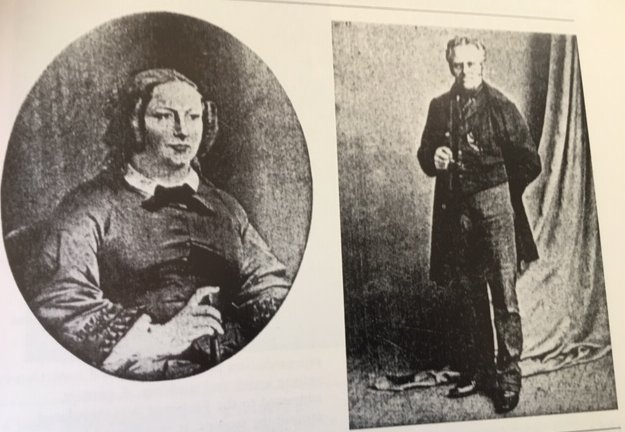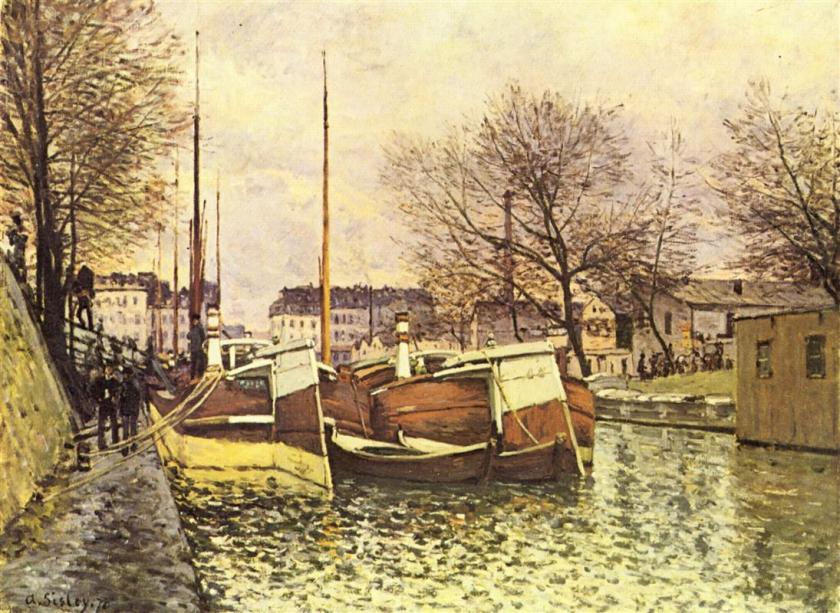
The artist I am looking at today is not one of my “unknown” painters I often showcase. This artist is well known and his works are in collections all around the world. Today’s featured painter is Alfred Sisley.

Alfred Sisley was born on October 30th 1839 at 19 rue des Trois Bornes which was in what was then the 4th arrondissement of Paris. He was the son of the British couple, William Sisley, and Felicity Sisley (née Sell) and although born in France, he retained his British citizenship. Little is known about his siblings. Some articles say he was one of four children, others say he just had one older sibling who died young. Alfred’s maternal ancestors came from the English county of Kent and were said to have been smugglers and tradesmen. His parents were affluent. His father owned a silk exportation business which he had established in 1839. Little is known about Sisley’s schooling except to say in the Spring of 1857, when he was almost eighteen years old, his father sent him to London to learn how to embark on a career in commerce. It is clear that Sisley had neither an aptitude for, nor a love of, commerce. However, the upside for young Alfred was that being in London he was able to visit museums and exhibitions and began to fall in love with the works of Gainsborough, Turner and Constable as well as the Dutch and Flemish artists, such as Hobbema and Ruisdael, which he saw at the National Gallery.

In 1860 Sisley returned home to Paris. Whether his father realised that his son lacked the ability to follow in his footsteps as a tradesman or whether Sisley had bombarded his father with his desire to become an artist, will never be known, but in 1860, Alfred Sisley began studying at the Paris École des Beaux-Arts within the atelier of Swiss artist Marc-Charles-Gabriel Gleyre. Many famous French artists had passed through Gleyere’s studio, such as Claude Monet, Pierre-Auguste Renoir, Frédéric Bazille, James Abbott McNeill Whistler, and Auguste Toulmouche.
Sisley, like his friend Renoir and Monet, left the atelier Gleyre around 1864 when it closed and they decided to move to the rural area of Fontainebleau and the small town of Barbizon. Sisley worked in Chailly-en-Bière and later in Marlotte near Fontainebleau. Renoir recalled the days spent with Sisley. In a letter to the art critic Adolphe Tavernier, Renoir wrote:
“…When I was young, I would take my paintbox and a shirt, Sisley and I would leave Fontainebleau and walked until we reached a village. Sometimes we did not come back until we had run out of money about a week later…”

Renoir had been sharing Sisley’s Paris studio since July 1865 and in February 1866 the two of them along with Renoir’s friend, the artist Jules Le Coeur set out to walk across the Forest of Fontainebleau passing through the villages of Milly and Courances on their way to Marlotte, a village on the southern edge of the Fontainebleau Forest, close to the River Loing. Renoir immortalised the group in his 1866 painting The Inn of Mère Anthony. In the depiction we see that Renoir has had his friends, Le Coeur, Sisley, Mère Anthony and her daughter pose for the painting in the main room of the inn at Marlotte.

One of many paintings completed by Sisley around this time was entitled Village Street in Marlotte. The painting portrays a solitary figure chopping wood. A sombre palette of greens, browns, and grey-blues underscores an overall feeling of isolation. Unlike many of his contemporaries, Sisley seldom travelled and did not feel compelled to depict urban life, industrialization, and the more dramatic aspects of nature, contenting himself with painting the world close at hand.

Women going to the Woods by Alfred Sisley (1866)
Another work by Sisley was entitled Women going to the Woods and depicts three elderly women wrapped up against the cold who are setting out to the forest, probably to collect firewood and is a reminder that people were reliant on the forest for their existence. Both of Sisley paintings were exhibited at the 1866 Paris Salon.

In 1866 Sisley met a thirty-two-year-old florist named Marie-Louise Eugénie Adelaide Lescouezec. According to Renoir she seemed “exceedingly well bred.” Little is known about her upbringing but reports have it that her family’s financial hardships forced her to become an artist’s model, which often had an unsavoury connotation. Yet another account tells of her early life being difficult after her father, an officer, was killed in a duel when she was a young girl. None of this affected in any way Sisley’s love for her and he was to remain devoted to her until her death in 1898. On June 17th 1868, a year after they met, the couple’s son Pierre was born, followed by a daughter, Jeanne-Adèle, on January 29th 1869. Renoir painted the couple the year they were married. She was dressed in a bright-coloured red and yellow gown.

Avenue of Chestnut Trees near La Celle-Saint-Cloud by Alfred Sisley (1867)
At the 1868 Salon, Sisley had just one of his paintings exhibited. It was his Avenue of Chestnut Trees near La Celle-Saint-Cloud which he had completed the previous year. It was a large painting (96 x 122cms) and depicts a verdant view through a densely wooded part of the forest, six kilometres west of the village of La-Celle-Saint-Cloud, located in the western suburbs of Paris, 15 kms from the centre. This was the third time Sisley had depicted the forest in his painting. There had been two earlier works of differing sizes, both entitled Avenue of Chestnut Trees at La-Celle-Saint-Cloud, which he completed in 1865. The forest was very popular with Parisians who wanted to briefly escape city life. Look how Sisley has used a shifting range of greens and browns to bring the picture to life. Note the clever way he has used dappled brushwork on the trunks of the trees. Look how we are led through the avenue of trees which propels us back, penetrating the depth of the canvas. If you look closely at Sisley’s work you will notice a solitary deer on the right mid-ground almost lost from view camouflaged by the dark tree trunks. So why the solitary deer? It could well have something to do with having the painting accepted into the Salon by the jurists. Landscape paintings had an inferior position in the hierarchy of pictorial-subject matter by the art establishment, so maybe Sisley realised that a connection with the monarchy would stand him in good stead of having the Salon jury accept the work as his depiction was of the royal hunting grounds of Napoleon III.

This view down a majestic avenue of trees harks back to paintings Sisley may have seen whilst in London, such as one of his favourite artist’s works, The Avenue at Middelharnis, by Hobbema which hangs in the National Gallery.

Another work which may have influenced him and which he had probably seen at Musée d’Orsay, was Gustave LeGray’s 1855 photograph Forêt de Fontainebleau, sous-bois au Bas-Bréau [Forest of Fontainebleau, undergrowth at Bas-Bréau]. LeGray had received a commission from the committee for historic monuments to photograph the most noteworthy monuments in France and in 1852 and again in 1857 he produced two large collections of photographs of the Forest of Fontainebleau. It is reported that during his walks around Bas-Bréau, in the heart of the forest, LeGray would place his camera right in the middle of the path, at the exact place where he had been struck by the light shimmering through the foliage and he used the line of the path, in this rich composition, to draw the eye towards the clearing where the tree trunks are bathed in light. In this way he produced the image of a site that was very popular with painters. The depiction is all about the forest. There are no human or animal presence to disturb the natural spectacle.

Of all the Impressionist, Sisley was the one who loved the countryside the most and liked to paint rural scenes. He was not an urban painter and only completed a smaller number of works which focused on Paris and the Parisian scene favoured by the likes of Renoir and Monet. Indeed, of the very few paintings directly inspired by the French capital, some were depictions of the Canal Saint-Martin in the north-east of the city. It is a 4.6 km long canal in Paris, with nine locks, connecting the Canal de l’Ourcq to the River Seine. Originally built to supply the city with fresh water to support a growing population and help avoid diseases such as dysentery and cholera while also supplying fountains and allowing the streets to be cleaned. Construction of the canal started in 1802 and was completed in 1825. The canal was also used to supply Paris with grain, building materials and other goods, carried on canal boats. It formed part of a continuous network of waterways extending across the city connecting the upper and lower parts of the Seine. One of Sisley’s painting featuring the waterway was his 1870 painting Barges on the Canal Saint-Martin.
A similar work was his 1870 painting Vue du Canal Sint-Martin, which is housed at the Musée d’Orsay. Whereas other artists like Monet and Renoir

focused on the beauty of the French capital with its spacious sunlit boulevards created by Napoleon III and Baron Haussmann and the newly built apartment blocks. For artists like Renoir and Monet urban life was all about wealth and leisure. For Sisley it was about toil and poverty. He wanted to concentrate on the reality of Paris and life in the capital and not just the picturesque but idealised version of the metropolis and so he focused on the working quays of the Canal Saint-Martin. In the painting we see a wide stretch of the Canal St Martin near the Bassin de la Villette. On either side of the canal, houses and warehouses overlook the waterway and in the central midground is one of the locks. Further back and in the direction of central Paris buildings appear through the haze. Looking at his depiction we know there is a strong breeze which stirs up the water and the time of day deduced by looking at the length of the shadows made by the trees in the water, it must have been around midday. What is also important about Sisley’s painting is the way he has depicted the cloud formations and the nature of the light and its reflections on the water. He captures the moment with his use of a silvery palette of blues and greys, constantly thickening the paint for the highlights on the water. It would be one of the trademarks of his work as an Impressionist.
Alfred Sisley’s finances at this time were said to be at best, perilous and he often had to turn to friends and family for loans. Things were to get worse with the outbreak of the Franco-Prussian war in 1870. From September 1870 to January 1871, the French capital was besieged by Prussian forces and one of the dire consequences for Sisley was that his father’s business collapsed and William Sisley was financially ruined. His father lost everything and died shortly thereafter. Alfred’s money stream from his father was over. Sisley’s sole means of support became the sale of his works.
..……….to be continued

You ended with a cliffhanger (haha). I really love how you describe painters’ methods of applying paint to effect how the viewer experiences looking at the painting. Looking forward to the next post, and thank you so much for all your efforts.
This is lovely, thank you!
So far, the best Sisley’s works here are the two depictions of the Canal St. Martin. His rural landscapes are largely forgettable.